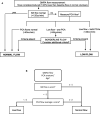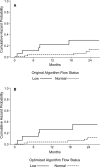Optimized Hemodynamic Assessment to Predict Stroke Risk in Vertebrobasilar Disease: Analysis From the VERiTAS Study
- PMID: 32500810
- PMCID: PMC7429025
- DOI: 10.1161/JAHA.120.016406
Optimized Hemodynamic Assessment to Predict Stroke Risk in Vertebrobasilar Disease: Analysis From the VERiTAS Study
Abstract
Background Atherosclerotic vertebrobasilar disease is a significant etiology of posterior circulation stroke. The prospective observational VERiTAS (Vertebrobasilar Flow Evaluation and Risk of Transient Ischemic Attack and Stroke) study demonstrated that distal hemodynamic status is a robust predictor of subsequent vertebrobasilar stroke risk. We sought to compare predictive models using thresholds for posterior circulation vessel flows standardized to age and vascular anatomy to optimize risk prediction. Methods and Results VERiTAS enrolled patients with recent vertebrobasilar transient ischemic attack or stroke and ≥50% atherosclerotic stenosis/occlusion in vertebral and/or basilar arteries. Quantitative magnetic resonance angiography measured large-vessel vertebrobasilar territory flow, and patients were designated as low or normal flow based on a prespecified empiric algorithm considering distal territory regional flow and collateral capacity. For the present study, post hoc analysis was performed to generate additional predictive models using age-specific normalized flow measurements. Sensitivity, specificity, and time-to-event analyses were compared between the algorithms. The original prespecified algorithm had 50% sensitivity and 79% specificity for future stroke risk prediction; using a predictive model based on age-normalized flows in the basilar and posterior cerebral arteries, standardized to vascular anatomy, optimized flow status thresholds were identified. The optimized algorithm maintained sensitivity and increased specificity to 84%, while demonstrating a larger and more significant hazard ratio for stroke on time-to-event analysis. Conclusions These results indicate that flow remains a strong predictor of stroke across different predictive models, and suggest that prediction of future stroke risk can be optimized by use of vascular anatomy and age-specific normalized flows.
Keywords: blood flow; magnetic resonance angiography; magnetic resonance imaging; quantitative magnetic resonance angiography; stroke vertebrobasilar disease.
Figures



References
-
- Caplan LR, Wityk RJ, Glass TA, Tapia J, Pazdera L, Chang HM, Teal P, Dashe JF, Chaves CJ, Breen JC, et al. New England Medical Center Posterior Circulation registry. Ann Neurol. 2004;56:389–398. - PubMed
-
- Qureshi AI, Qureshi MH, Lien LM, Lee JT, Jeng JS, Hu CJ, Lai TC, Liu CH, Chen CH, Chen PL, et al. One‐year risk of recurrent stroke and death associated with vertebrobasilar artery stenosis and occlusion in a cohort of 10,515 patients. Cerebrovasc Dis. 2019;47:40–47. - PubMed
-
- Michel P, Odier C, Rutgers M, Reichhart M, Maeder P, Meuli R, Wintermark M, Maghraoui A, Faouzi M, Croquelois A, et al. The acute stroke registry and analysis of Lausanne (ASTRAL): design and baseline analysis of an ischemic stroke registry including acute multimodal imaging. Stroke. 2010;41:2491–2498. - PubMed
-
- Vemmos KN, Takis CE, Georgilis K, Zakopoulos NA, Lekakis JP, Papamichael CM, Zis VP, Stamatelopoulos S. The Athens stroke registry: results of a five‐year hospital‐based study. Cerebrovasc Dis. 2000;10:133–141. - PubMed
-
- Labropoulos N, Nandivada P, Bekelis K. Stroke of the posterior cerebral circulation. Int Angiol. 2011;30:105–114. - PubMed
Publication types
MeSH terms
Grants and funding
LinkOut - more resources
Full Text Sources
Medical

